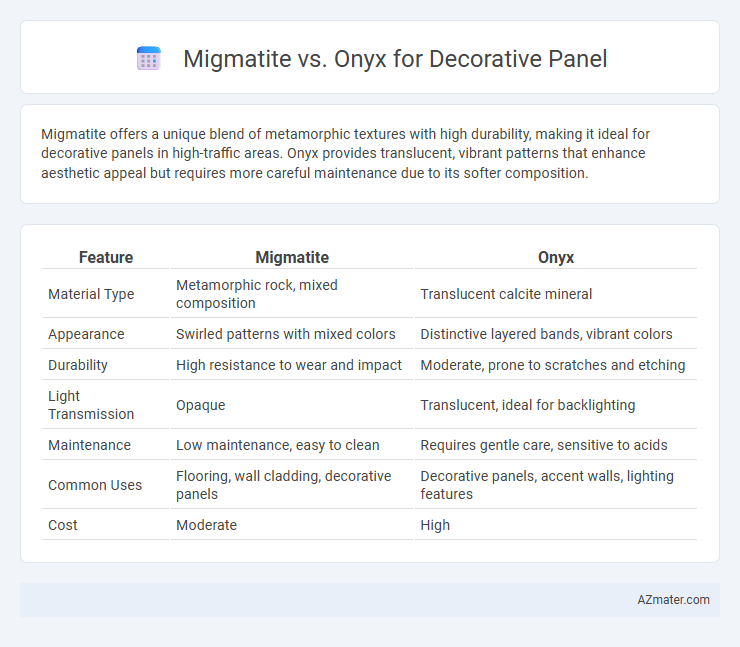Migmatite offers a unique blend of metamorphic textures with high durability, making it ideal for decorative panels in high-traffic areas. Onyx provides translucent, vibrant patterns that enhance aesthetic appeal but requires more careful maintenance due to its softer composition.
Table of Comparison
| Feature | Migmatite | Onyx |
|---|---|---|
| Material Type | Metamorphic rock, mixed composition | Translucent calcite mineral |
| Appearance | Swirled patterns with mixed colors | Distinctive layered bands, vibrant colors |
| Durability | High resistance to wear and impact | Moderate, prone to scratches and etching |
| Light Transmission | Opaque | Translucent, ideal for backlighting |
| Maintenance | Low maintenance, easy to clean | Requires gentle care, sensitive to acids |
| Common Uses | Flooring, wall cladding, decorative panels | Decorative panels, accent walls, lighting features |
| Cost | Moderate | High |
Introduction to Migmatite and Onyx
Migmatite is a composite rock featuring a blend of metamorphic and igneous components, characterized by its intricate swirling patterns and durable structure, making it ideal for long-lasting decorative panels. Onyx, a form of banded calcite or aragonite, offers translucent qualities with striking linear bands and vibrant colors, often used to create visually stunning, backlit decorative panels. Both materials provide unique aesthetic appeals, with migmatite emphasizing natural stone complexity and onyx highlighting luminous elegance in interior design.
Geological Origins and Composition
Migmatite forms through high-grade metamorphism involving partial melting of pre-existing rocks, resulting in a heterogeneous composition of both igneous and metamorphic materials, typically quartz, feldspar, and mica. Onyx is a banded variety of chalcedony formed by the deposition of silica from cold water solutions, primarily composed of microcrystalline quartz with distinct parallel bands of contrasting colors. The geological origin of migmatite reflects intense heat and pressure conditions deep within the Earth's crust, while onyx develops in sedimentary or volcanic environments through mineral precipitation.
Appearance and Color Variations
Migmatite showcases a striking blend of light and dark mineral bands with a swirling, marbled appearance, offering unique, natural patterns ideal for decorative panels seeking an organic, dynamic look. Onyx features translucent layers with rich, vibrant color variations ranging from creamy whites and amber tones to deep greens and reds, providing luminous depth and elegance in design applications. The contrasting textures of migmatite's coarse, crystalline structure and onyx's smooth, glass-like surface cater to diverse aesthetic preferences in interior decor.
Strength and Durability Comparison
Migmatite offers exceptional strength and durability due to its unique formation process, combining metamorphic and igneous properties that enhance resistance to weathering and stress. Onyx, while prized for its aesthetic translucency and intricate banding, tends to be softer and more prone to scratching and chipping compared to migmatite. For decorative panels requiring long-lasting performance in high-traffic or exterior environments, migmatite's robust composition makes it a superior choice over the more delicate onyx.
Maintenance and Care Requirements
Migmatite panels require minimal maintenance, needing only regular dusting and occasional sealing to preserve their natural veining and prevent moisture absorption. Onyx panels demand more careful upkeep due to their porous nature, requiring frequent sealing and gentle cleaning with pH-neutral products to avoid etching or discoloration. Choosing Migmatite offers durability and easier long-term care, while Onyx requires vigilant maintenance to maintain its translucent beauty in decorative applications.
Applications in Decorative Panels
Migmatite offers rich, natural patterns with a blend of metamorphic textures, making it ideal for high-end decorative panels that require a unique, organic aesthetic. Onyx provides vibrant translucency and striking color variations, perfect for backlit panels and accent walls to create dramatic visual effects. Both materials are valued in luxury interior design, with migmatite emphasizing durability and texture, while onyx excels in delivering luminous, artistic statements.
Cost and Availability Analysis
Migmatite panels generally have a higher cost due to their complex formation involving metamorphic and igneous processes, resulting in unique, intricate patterns that are less common and thus priced at a premium. Onyx panels, while also considered luxurious, tend to be more readily available and vary in price depending on quality and source, often making them a more accessible option for decorative purposes. Availability of migmatite is limited by geographic and mining constraints, whereas onyx deposits are more widespread, influencing both cost and sourcing efficiency for interior design projects.
Environmental Impact and Sustainability
Migmatite and onyx offer distinct environmental impacts when used as decorative panels, with migmatite typically sourced from natural formations involving high-temperature metamorphic processes, making extraction energy-intensive but durable with low maintenance needs. Onyx, prized for its translucent beauty, often requires more energy-intensive quarrying and processing methods, which can contribute to higher carbon emissions and waste. Choosing migmatite panels enhances sustainability due to its longer lifespan and minimal chemical treatments, whereas onyx demands careful sourcing and potential recycling efforts to reduce its environmental footprint.
Design Trends and Aesthetic Appeal
Migmatite panels offer unique, natural patterns blending igneous and metamorphic features, creating a sophisticated, organic aesthetic favored in contemporary interior design. Onyx provides translucent qualities with vibrant, layered colors that capture light, enhancing luxury spaces with dramatic visual effects. Both materials align with current trends emphasizing texture and natural beauty, but Onyx's luminescence often makes it the preferred choice for statement decorative panels.
Choosing Between Migmatite and Onyx
Choosing between migmatite and onyx for a decorative panel depends on factors like durability, visual appeal, and cost. Migmatite offers a unique blend of metamorphic features with intricate patterns and superior strength, making it ideal for high-traffic areas. Onyx delivers translucent beauty with vibrant colors and striking veining, best suited for accent pieces where aesthetic impact is prioritized over hardness.

Infographic: Migmatite vs Onyx for Decorative Panel
 azmater.com
azmater.com